Riverbank Wild Rye
Elymus riparius
Grass family (Poaceae)
Elymus riparius
Grass family (Poaceae)
Description:
This perennial grass forms tufts of leafy culms about 20–140" (50–350
cm.) tall. The culms are light to medium green, hairless, terete, and
unbranched; there are several alternate leaves along the length of each
culm that are ascending, arching, or widely spreading. The linear leaf
blades are 4–10" (10–25 cm.) long, 7–16 mm. wide, and flat; each leaf
blade clasps the culm at its base with a pair of small auricles (eared
basal lobes). The leaf blade surface is light to medium green or bluish
tinted, dull-colored (rather than shiny), and usually scabrous
(rough-textured). Similarly, the open leaf sheaths are light to medium
green or bluish tinted, vertically veined, and hairless, except along
their margins, where they are sometimes ciliate.
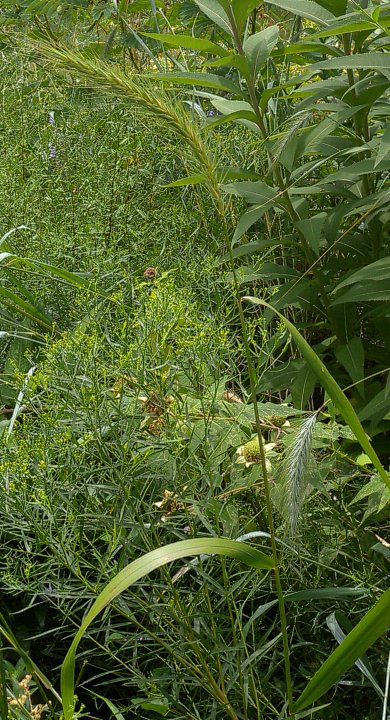
Each fertile culm terminates in a spike-like nodding inflorescence that is 3–8" (7.5–20 cm.) long. Along the central axis of this inflorescence, there are moderately dense clusters of 2–3 spikelets facing in all directions. Each spikelet consists of a pair of ascending glumes (non-fertile or empty scales) at the bottom and 2–4 ascending lemmas (fertile scales) above; the latter are arranged in 2 loose ranks. Each glume is 15–30 mm. long (including its awn), 0.3–1 mm. wide (toward the base), and linear in shape, tapering gradually into a long straight awn toward the middle. The base of each glume is somewhat hardened and thickened; 1–3 longitudinal veins are usually visible along the body of the glume below its awn. Each lemma is 20–40 mm. long (including its awn), linear-lanceolate or linear-elliptic in shape, tapering gradually into a long straight awn that is about twice the length of the lemma's body. The body of the lemma has 3–5 faint longitudinal veins and it is convex along its outer surface. A perfect floret is located along the inner side of each lemma; it has exserted feathery stigmas and anthers. Opposite from each lemma there is a narrow membranous palea that is 6.5–8 mm. long; the apex of the palea is rounded or truncate, usually with a shallow notch in the middle.
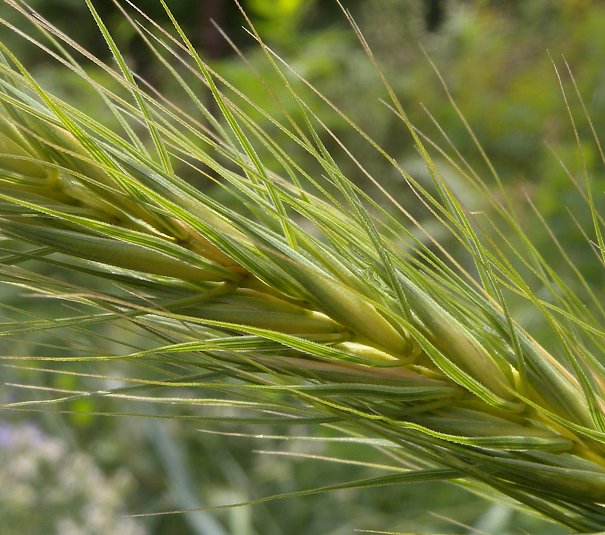
The blooming period occurs during mid-summer or late summer, lasting about 1–2 weeks. The florets are cross-pollinated by the wind. Afterwards, mature spikelets disarticulate above the glumes and between the florets. The florets are replaced by somewhat flattened and elongated grains. The root system consists of a crown of fibrous roots. This grass can form clonal offsets through its root system. By late autumn, this grass dies down to a loose cluster of low basal leaves that are semi-evergreen. In this state it overwinters until the spring, when new leafy culms develop.
Cultivation: The preference is full sun to light shade, moist to mesic conditions, and soil containing loam, clay-loam, or silt. Most growth and development occurs from mid-spring to summer. This grass has a cool-season C3 metabolism, so it matures more quickly than most warm-season grasses.
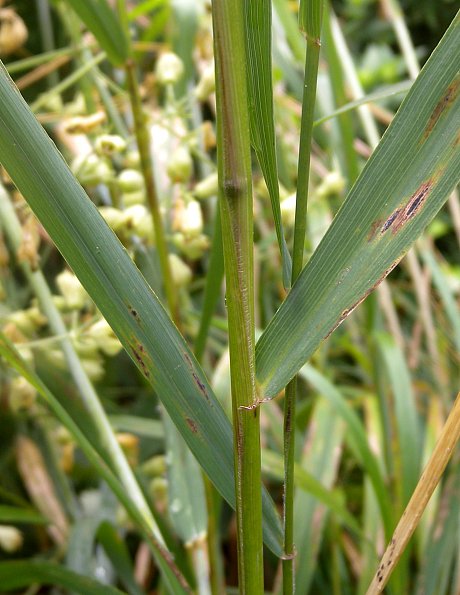
Range & Habitat: Riverbank Wild Rye (Elymus riparius) occurs in scattered locations throughout Illinois, where it native and uncommon (see Distribution Map). This grass occurs primarily in the Midwest and NE areas of the United States. Habitats include cemetery prairies (in Indiana), open bottomland woodlands, rocky woodlands along rivers, wooded bluffs and slopes, moist savannas, banks of rivers, and moist ground along woodland streams. This grass occurs in natural areas with some history of disturbance and also high quality natural areas. Occasional mowing or ground fires are probably beneficial in maintaining populations of this grass by reducing competition from woody plants.
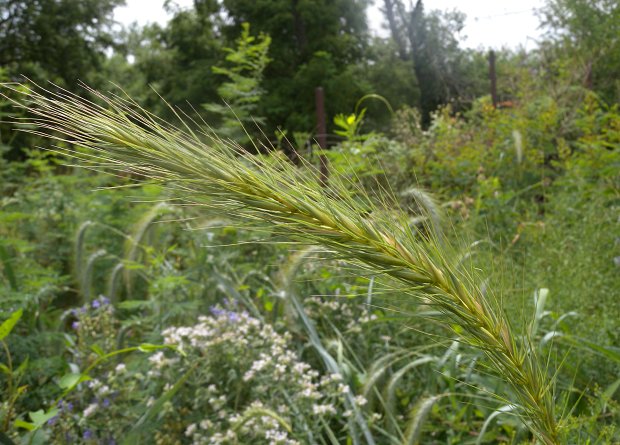
Faunal Associations: Riverbank Wild Rye (Elymus riparius) probably attracts many of the same insects as other Wild Rye grasses (Elymus spp.). This would include such insect feeders as the larvae of leaf-mining flies (Cerodontha spp.), larvae of leaf-mining moths (Elachista spp.), larvae of a leaf beetle (Chalepus walshii), larvae of the Grass-stem Sawfly (Cephus cinctus), larvae of the Wild Rye Jointworm (Tetramesa elymi), the Four-humped Stink Bug (Brochymena quadripustulata) and other stink bugs, aphids (Carolinaia spp. and others), a leafhopper (Elymana acuma), and miscellaneous mealybugs (Spencer & Steyskal, 1986; Microleps website, 2010; Eiseman, 2016; Felt, 1917; Rider, 2009; Blackman & Eastop, 2013; Panzer et al., 2006; ScaleNet website, 2014). The large seeds or Riverbank Wild Rye and other Wild Rye grasses are eaten by various small rodents, including the White-footed Mouse, Deer Mouse, Meadow Jumping Mouse, and wild House Mouse (Whitaker, 1966; Whitaker & Mumford, 1970). The young foliage of these grasses are edible to many hoofed mammalian herbivores, however the heavily awned seedheads of these grasses at maturity can cause mechanical injury to the digestive tracts and eyes of livestock.
Photographic Location: The wildflower garden of the webmaster in Urbana, Illinois.
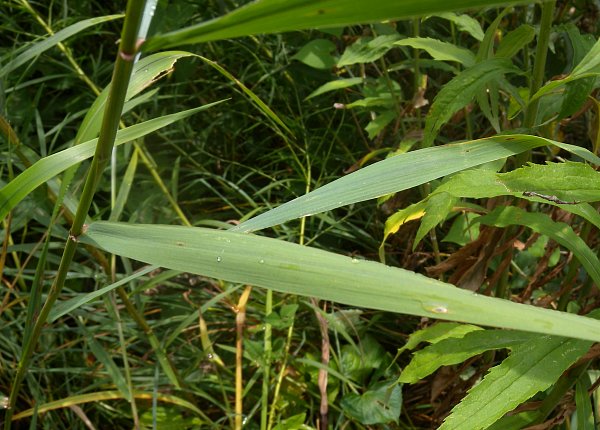
Comments: This is one of the lesser-known and less common Wild Rye grasses (Elymus spp.). It is rarely cultivated and often overlooked in habitat restorations; hopefully this will change in the future. Riverbank Wild Rye (Elymus riparius) is perhaps most similar in appearance to Silky Wild Rye (Elymus villosus) because both of these grasses produce nodding inflorescences that are more slender than those of Canada Wild Rye (Elymus canadensis). The inflorescences of the latter grass also tend to droop more and their awns curve outward as they mature, instead of remaining straight like the awns of Riverbank Wild Rye and Silky Wild Rye. In general, Riverbank Wild Rye lacks the pubescent leaf sheaths and leaf blades that are often found on Silky Wild Rye, and the lemmas of Riverbank Wild Rye, while often sparsely hairy, lack the fine pubescence that can be found on the lemmas of Silky Wild Rye. Another difference between these two grasses is the size of the their respective paleas (membranous inner scales): Riverbank Wild Rye tends to have longer paleas. Another common species, Virginia Wild Rye (Elymus virginicus), can be readily distinguished from the preceding grasses by its erect inflorescences.

Each fertile culm terminates in a spike-like nodding inflorescence that is 3–8" (7.5–20 cm.) long. Along the central axis of this inflorescence, there are moderately dense clusters of 2–3 spikelets facing in all directions. Each spikelet consists of a pair of ascending glumes (non-fertile or empty scales) at the bottom and 2–4 ascending lemmas (fertile scales) above; the latter are arranged in 2 loose ranks. Each glume is 15–30 mm. long (including its awn), 0.3–1 mm. wide (toward the base), and linear in shape, tapering gradually into a long straight awn toward the middle. The base of each glume is somewhat hardened and thickened; 1–3 longitudinal veins are usually visible along the body of the glume below its awn. Each lemma is 20–40 mm. long (including its awn), linear-lanceolate or linear-elliptic in shape, tapering gradually into a long straight awn that is about twice the length of the lemma's body. The body of the lemma has 3–5 faint longitudinal veins and it is convex along its outer surface. A perfect floret is located along the inner side of each lemma; it has exserted feathery stigmas and anthers. Opposite from each lemma there is a narrow membranous palea that is 6.5–8 mm. long; the apex of the palea is rounded or truncate, usually with a shallow notch in the middle.

The blooming period occurs during mid-summer or late summer, lasting about 1–2 weeks. The florets are cross-pollinated by the wind. Afterwards, mature spikelets disarticulate above the glumes and between the florets. The florets are replaced by somewhat flattened and elongated grains. The root system consists of a crown of fibrous roots. This grass can form clonal offsets through its root system. By late autumn, this grass dies down to a loose cluster of low basal leaves that are semi-evergreen. In this state it overwinters until the spring, when new leafy culms develop.
Cultivation: The preference is full sun to light shade, moist to mesic conditions, and soil containing loam, clay-loam, or silt. Most growth and development occurs from mid-spring to summer. This grass has a cool-season C3 metabolism, so it matures more quickly than most warm-season grasses.

Range & Habitat: Riverbank Wild Rye (Elymus riparius) occurs in scattered locations throughout Illinois, where it native and uncommon (see Distribution Map). This grass occurs primarily in the Midwest and NE areas of the United States. Habitats include cemetery prairies (in Indiana), open bottomland woodlands, rocky woodlands along rivers, wooded bluffs and slopes, moist savannas, banks of rivers, and moist ground along woodland streams. This grass occurs in natural areas with some history of disturbance and also high quality natural areas. Occasional mowing or ground fires are probably beneficial in maintaining populations of this grass by reducing competition from woody plants.

Faunal Associations: Riverbank Wild Rye (Elymus riparius) probably attracts many of the same insects as other Wild Rye grasses (Elymus spp.). This would include such insect feeders as the larvae of leaf-mining flies (Cerodontha spp.), larvae of leaf-mining moths (Elachista spp.), larvae of a leaf beetle (Chalepus walshii), larvae of the Grass-stem Sawfly (Cephus cinctus), larvae of the Wild Rye Jointworm (Tetramesa elymi), the Four-humped Stink Bug (Brochymena quadripustulata) and other stink bugs, aphids (Carolinaia spp. and others), a leafhopper (Elymana acuma), and miscellaneous mealybugs (Spencer & Steyskal, 1986; Microleps website, 2010; Eiseman, 2016; Felt, 1917; Rider, 2009; Blackman & Eastop, 2013; Panzer et al., 2006; ScaleNet website, 2014). The large seeds or Riverbank Wild Rye and other Wild Rye grasses are eaten by various small rodents, including the White-footed Mouse, Deer Mouse, Meadow Jumping Mouse, and wild House Mouse (Whitaker, 1966; Whitaker & Mumford, 1970). The young foliage of these grasses are edible to many hoofed mammalian herbivores, however the heavily awned seedheads of these grasses at maturity can cause mechanical injury to the digestive tracts and eyes of livestock.
Photographic Location: The wildflower garden of the webmaster in Urbana, Illinois.

Comments: This is one of the lesser-known and less common Wild Rye grasses (Elymus spp.). It is rarely cultivated and often overlooked in habitat restorations; hopefully this will change in the future. Riverbank Wild Rye (Elymus riparius) is perhaps most similar in appearance to Silky Wild Rye (Elymus villosus) because both of these grasses produce nodding inflorescences that are more slender than those of Canada Wild Rye (Elymus canadensis). The inflorescences of the latter grass also tend to droop more and their awns curve outward as they mature, instead of remaining straight like the awns of Riverbank Wild Rye and Silky Wild Rye. In general, Riverbank Wild Rye lacks the pubescent leaf sheaths and leaf blades that are often found on Silky Wild Rye, and the lemmas of Riverbank Wild Rye, while often sparsely hairy, lack the fine pubescence that can be found on the lemmas of Silky Wild Rye. Another difference between these two grasses is the size of the their respective paleas (membranous inner scales): Riverbank Wild Rye tends to have longer paleas. Another common species, Virginia Wild Rye (Elymus virginicus), can be readily distinguished from the preceding grasses by its erect inflorescences.